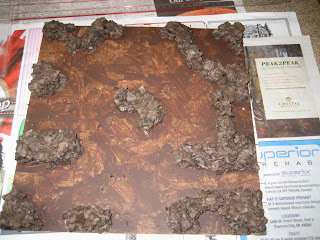Scenario Objectives: The drone was set up in the middle of the table, at the beginning of each turn it moved 1d6 inches in a random direction. If a model from either side was in contact, it no longer moved and once per turn the model could try to download the memory file on a 4+. Then the model with the download had to move off the board through a passage on his side.
The New Israeli's had a two anti-grav drones and a three spider drones. They also had two 6 man fire-teams with four riflemen, a LMG and a RPG in each team. The drones proved to be very tough and very reliable.
The Krystrial had four fire teams, each with four models. There were 12 Raivaui armed with laser weapons which made up up 3 of the teams, and 4 veteran Krystrial soldiers with shotguns.
We played the scenario a couple of times using different map configurations. The tight narrow corridors make for some pretty close and deadly combat. My Raivaui managed to reach the drone first in both games. Once in contact, they quickly came under fire while trying to download the data and between suppression, bad rolls, and attempts to get the data would be pinned in the same spot for most of the game, while I maneuvered two teams up to support them, and kept the last to cover their path of retreat.
Eventually, the combined fire power of the three fire teams caused the New Israel's to fail a few activations, and the team with the data managed to withdraw behind a screen of other fire teams. Both games were pretty close, with the Israeli's drones moving in quickly and making contact before their infantry teams could move into position to support them. The Krystrial Empire took heavier causalities (about 50% each game) while the Israeli's lost a lot of drones.
I think if we had at least two more boards with less cover it would improve this kind of scenario. On a 2'x2' board with so much cover the benefits of the laser rifle over the assault rifle are minimized. In addition a 12" run gets you to and from the objective pretty rapidly, especially if the opposition force fails activations. We are using the fourth edition rules + generic sci-fi.













